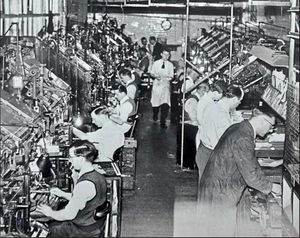Express & Star's archive of historic photos is 'the greatest legacy'
Hazel Jones was one of the caretakers of our shared history.

As a librarian at the Express & Star, she was the person responsible for cataloguing precious photographs that are now at the heart of a bid to create a free, digital archive for everyone to use.
Miss Jones was straight out of school in 1942 when she came to work at the Queen Street head office under chief librarian Dora Roston.
Together, their duties included storing and maintaining an archive of photographs that today encompasses one million images dating back more than a century.
Now, 88-year-old Miss Jones is backing a bid to digitise the photographs which will preserve them for generations to come.
The funding is to be used in order to develop plans to seek a full grant for the project.
The initiative aims to carry out vital archiving work, digitise the collection and make the photographs available through a single web portal, allowing free online public access to the unrivalled images of local events, momentous and everyday, for the first time.
Miss Jones spent seven years with the E&S from the age of 16. She was taken on straight from Wolverhampton Girls' High School. Miss Jones later moved to London and worked for the Mirror Group of newspapers just off Fleet Street until 1989 but has retired to Penn.

While at the Mirror Group she worked with pictures stored in glass negative form dating back to the 1890s that had been saved from possible destruction and lovingly sorted and catalogued. This gave her an appreciation of the importance of the pictures and how valuable they are – not financially, but to history.
Standing in the E&S archive, stuffed with envelopes containing our own precious images, Miss Jones recalls the way she and Dora would work.
"I had no experience after leaving school," Miss Jones says.
"For the first six months whenever Dora went on her lunch break she would leave me with a copy of The Times and The Daily Telegraph to read cover to cover and then set me questions on it. She realised how ignorant I was."
Miss Jones became responsible for the photographs.
"There was little newsprint at the time because of the war," she says. "Whenever a picture of someone was needed, there would be a little head block. It was metal with their picture etched into it. Part of my job was to go to the store to collect it for filing." Today, reporters and news editors can find pictures in a matter of seconds.
But Miss Jones played a vital role in the production of the newspaper.
"If anyone needed a picture we could usually find it for them in a few minutes and bring it to them," Miss Jones says.
"The important thing was to make sure there was a full caption on it.
"A habit I picked up from my career was to caption every photograph I take.
"You had to have your five Ws – who, what, why, where and when.
"Without them, it would be lost in the library."
Pages were made on a stone in a composing room, using hot metal sheets.

National and international news – a staple part of all newspapers during the Second World War – would come into the tape room. It would appear in Morse code on a tape.
Agencies such as the Press Association and Reuters would send images from London by train.
That was a particularly vital part of the operation on the day that Princess Elizabeth married Philip Mountbatten in 1947.
The photographs would be displayed in the window of the newspaper's office for people to be able to order copies.
But it is the images from the liberation of the Belsen Nazi concentration camp that Miss Jones recalls the most vividly. She does not go into detail about what she saw.
But Dora Roston did not want to file them away herself.
"The first photographs came in and had gone to the news editor.
"He decided what to use in the paper and what to keep in the library.
"We would collect pictures every day. But Dora gave me the ones from Belsen and said 'put these where I cannot find them'.
"I put them in a drawer in one of the six to eight filing cabinets we had."
While the newspaper archive will contain pictures of some of the monumental days in our history, it is also full of images telling the story of both the Black Country and Staffordshire.
"I knew at the time that these images were important," Miss Jones says. "And I think it's very important to keep them now.
"A collection like this is historical and it is also special for so many reasons."
The Express & Star photo archive has been described as one of the most important regional photograph collections in the country.
The collection includes iconic images such as one of American civil rights activist Malcolm X visiting Smethwick, just nine days before he was assassinated in 1965.

A host of leading historians paid tribute to the collection when it was awarded the Heritage Lottery Fund cash. Historian and author Carl Chinn said: "The Express & Star collection is essential to an understanding of the mentalité, the thought processes, values, and beliefs shared by the folk of the West Midlands.
"And crucially, photographs are a more democratic and inclusive source that help give a voice to those excluded from traditional histories."
Wolverhampton historian Billy Howe said there was a 'definite need' to make the archive accessible to the public.
He added: "There is no greater legacy anyone could offer the people of the Black Country that a pictorial history of its past."





